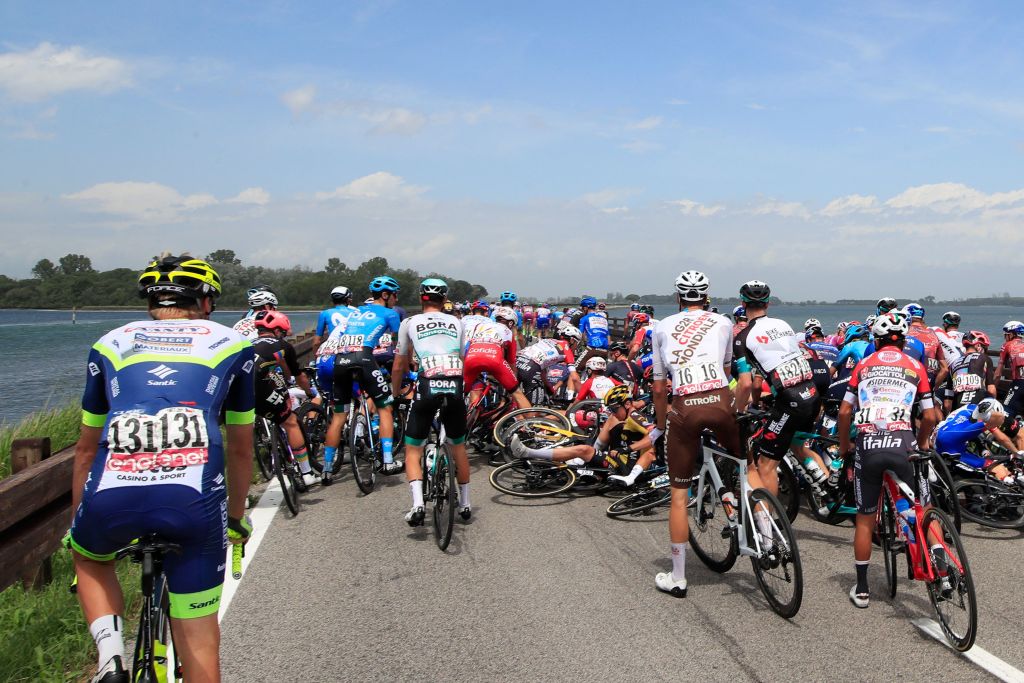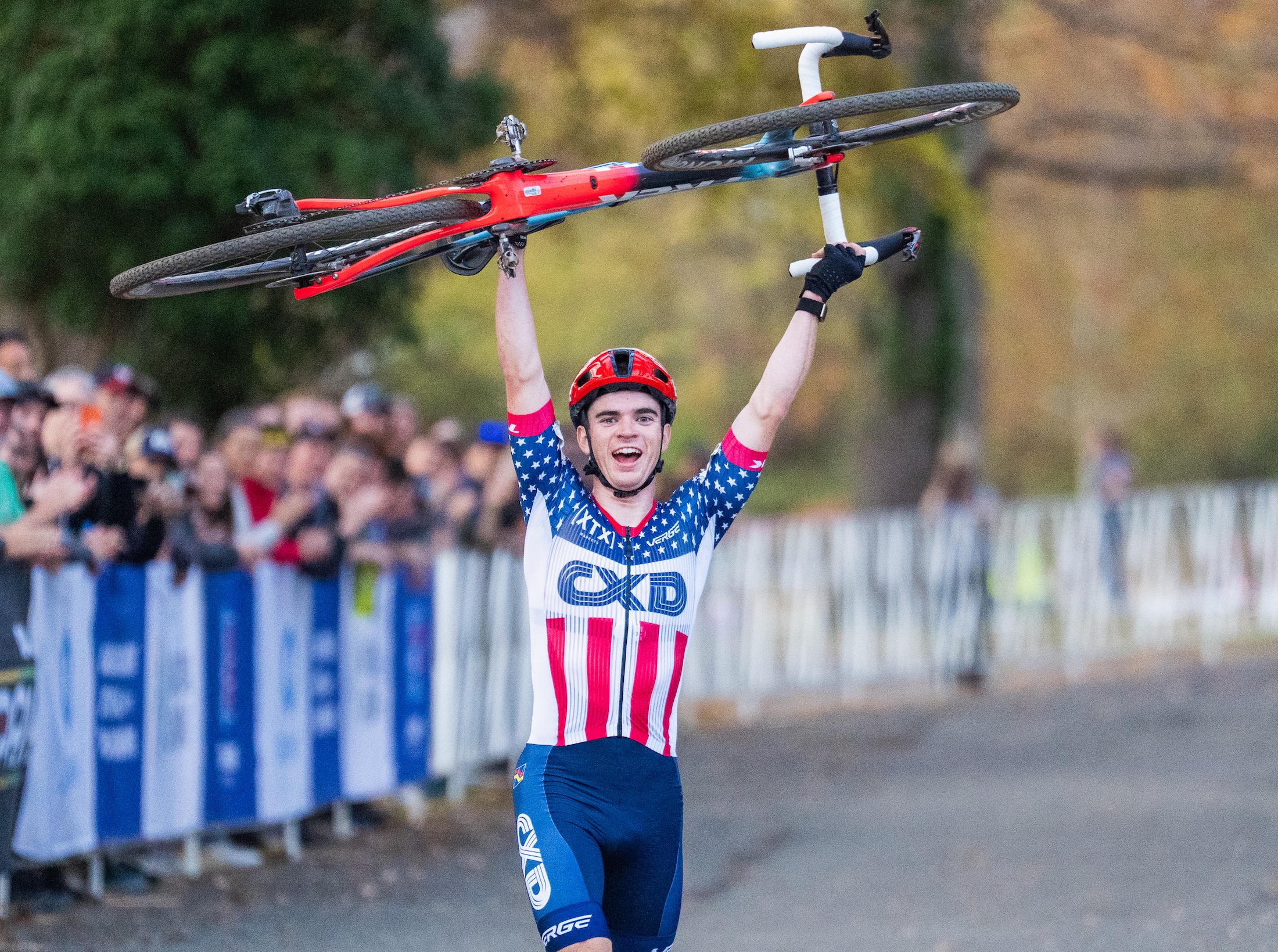Battle for break pinpointed as possible cause of massive Giro d'Italia crash
Buchmann, Berhane, Van Emden, Guerreiro all withdraw due to crash injuries

One of the largest crashes in recent years of the Giro d'Italia early on stage 15 was likely caused when riders were fighting to get in the early break of the day, riders and team management have said.
The mass crash on a causeway just outside the start town of Grado saw dozens of riders suffer minor injuries, and four abandon completely. The race was stopped for around 25 minutes as ambulances and emergency services handled the large number of injured riders.
Emanuel Buchmann (Bora-Hansgrohe), sixth overall, was amongst those forced to abandon the race, with his team later revealing that the German sustained a "mild concussion and several bruises on his face and hip" as well as a cut lip.
Natnael Berhane (Cofidis), Jos Van Emden (Jumbo-Visma) and – 18 kilometres after the restart – Ruben Guerreiro (EF Education-Nippo) also left the race due to their injuries.
"With the race just started and with so many riders on the ground needing medical treatment, we decided to block everything to give the teams time to tend to their riders. We stopped the race for 20 minutes or so and then restarted it. I think it's the right thing to do when something like that happens," race director Mauro Vegni said later.
"In 45 years of work, I've unfortunately had other neutralisations like that. Today it was about the quantity of riders involved in the crash rather than the seriousness of it. In others, it was because of the seriousness of what happened, but I think it was our duty to do this out of respect for the riders."
As for exactly what caused the crash, a combination of the very high speed and riders in a full peloton fresh out of the start jockeying for position to get in the break has been touted as the most likely theory so far.
The latest race content, interviews, features, reviews and expert buying guides, direct to your inbox!
Colombian rider Juan Sebastian Molano (UAE Team Emirates) said after the stage that "it was a bit of a strange start, nobody was really controlling things, and there was a longish neutralised section."
Part of the break of the day, he said, "Everybody wanted to be in a move, so things got pretty fraught, and for sure that's what caused it. I just hope everybody's OK."
"It was a really huge crash, we were going at more than 60 kph right at the start, maybe it was somebody's fault, maybe not, either way it's just not clear," added the King of the Mountains leader Geoffrey Bouchard (AG2R Citroën).
"I got lucky, I broke my shoe and that was it, but other guys weren't so fortunate. Lots of guys went down and quite a few went home."
The stage start on a lagoon town of Grado, and then crossing a long, straight, exposed causeway out of the town and back to the mainland arguably played a key part in increasing the effect of the crash. And according to EF Education-Nippo directeur sportif Tom Southam, the sheer pace of the peloton a knock-on effect as well.
"There was a roaring tailwind as we were going across the bridge and that increased the speed a lot," Southam told Cyclingnews after the stage. "Everybody wanted to be in the break, but it happened in the middle or the back of the bunch and with the road being dead straight and that speed, the size of the crash was amplified.
"Even without the wind, everybody was nervous, looking round. And when it happened, a lot of riders were injured."
Southam provided an update on Guerreiro, saying the Portuguese rider has gone to hospital for X-rays and potentially has a rib fracture. The other EF Education-Nippo riders were all OK, he said.
He added he believed that the organisation had taken the right decision to stop the race for nearly 25 minutes given the chaos at the scene and the consequences of not halting the stage.
"With team cars not being able to move, groups restarting all over the place, some guys would never have got back into the race. I think it was the right decision."
Of the GC teams, Bora-Hansgrohe suffered a major blow with Buchmann out of the race, with maglia ciclamino Peter Sagan – who was at the front of the bunch so didn't see the accident happen – expressing the team's collective disappointment.
"He was our team leader and also the guys did everything to keep him well-positioned, he was also going well on GC;" Sagan said afterwards, "five of the last stages of the race are for climbers like him, so it's a very bad thing."
Alasdair Fotheringham has been reporting on cycling since 1991. He has covered every Tour de France since 1992 bar one, as well as numerous other bike races of all shapes and sizes, ranging from the Olympic Games in 2008 to the now sadly defunct Subida a Urkiola hill climb in Spain. As well as working for Cyclingnews, he has also written for The Independent, The Guardian, ProCycling, The Express and Reuters.

